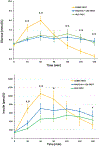The impact of food order on postprandial glycaemic excursions in prediabetes
- PMID: 30101510
- PMCID: PMC7398578
- DOI: 10.1111/dom.13503
The impact of food order on postprandial glycaemic excursions in prediabetes
Abstract
Data suggest that nutrient order during a meal significantly impacts postprandial glucose and insulin excursions in type 2 diabetes, while its effects in prediabetes have not been reported. Fifteen participants with prediabetes consumed the same meal on 3 days in random order: carbohydrate first, followed 10 minutes later by protein and vegetables (CF); protein and vegetables first, followed 10 minutes later by carbohydrate (PVF); or vegetables first followed by protein and carbohydrate (VF). Blood was sampled for glucose and insulin measurements at 0, 30, 60, 90, 120, 150 and 180 minutes. Incremental glucose peaks were similarly attenuated by >40% in the PVF and VF meal conditions compared with CF. The incremental area under the curve for glucose was 38.8% lower following the PVF meal order, compared with CF, and postprandial insulin excursions were significantly lower in the VF meal condition compared with CF. The CF meal pattern showed marked glycaemic variability whereas glucose levels were stable in the PVF and VF meal conditions. Food order presents a novel, simple behavioural strategy to reduce glycaemic excursions in prediabetes.
Keywords: clinical physiology; dietary intervention.
© 2018 John Wiley & Sons Ltd.
Conflict of interest statement
Conflict of interest
The authors have no conflicts of interest to disclose.
Figures

Similar articles
-
Postprandial glucose, insulin and incretin responses differ by test meal macronutrient ingestion sequence (PATTERN study).Clin Nutr. 2020 Mar;39(3):950-957. doi: 10.1016/j.clnu.2019.04.001. Epub 2019 Apr 27. Clin Nutr. 2020. PMID: 31053510 Clinical Trial.
-
The influence of food order on postprandial glucose levels in children with type 1 diabetes.Pediatr Diabetes. 2018 Jun;19(4):809-815. doi: 10.1111/pedi.12640. Epub 2018 Mar 12. Pediatr Diabetes. 2018. PMID: 29527759 Clinical Trial.
-
Impact of First Meal Size during Prolonged Sitting on Postprandial Glycaemia in Individuals with Prediabetes: A Randomised, Crossover Study.Nutrients. 2018 Jun 6;10(6):733. doi: 10.3390/nu10060733. Nutrients. 2018. PMID: 29882811 Free PMC article. Clinical Trial.
-
Impact of dietary protein on postprandial glycaemic control and insulin requirements in Type 1 diabetes: a systematic review.Diabet Med. 2019 Dec;36(12):1585-1599. doi: 10.1111/dme.14119. Epub 2019 Oct 10. Diabet Med. 2019. PMID: 31454430
-
Effects of different types of meals on postprandial glycaemia in healthy subjects.Pediatr Endocrinol Diabetes Metab. 2024;30(3):159-162. doi: 10.5114/pedm.2024.142587. Pediatr Endocrinol Diabetes Metab. 2024. PMID: 39451188 Free PMC article. Review.
Cited by
-
Gut-Based Strategies to Reduce Postprandial Glycaemia in Type 2 Diabetes.Front Endocrinol (Lausanne). 2021 Apr 9;12:661877. doi: 10.3389/fendo.2021.661877. eCollection 2021. Front Endocrinol (Lausanne). 2021. PMID: 33897622 Free PMC article. Review.
-
Optimizing Postprandial Glucose Management in Adults With Insulin-Requiring Diabetes: Report and Recommendations.J Endocr Soc. 2019 Oct 7;3(10):1942-1957. doi: 10.1210/js.2019-00222. eCollection 2019 Oct 1. J Endocr Soc. 2019. PMID: 31608313 Free PMC article.
-
A Randomized Controlled Pilot Study of the Food Order Behavioral Intervention in Prediabetes.Nutrients. 2023 Oct 20;15(20):4452. doi: 10.3390/nu15204452. Nutrients. 2023. PMID: 37892527 Free PMC article. Clinical Trial.
-
Competing paradigms of obesity pathogenesis: energy balance versus carbohydrate-insulin models.Eur J Clin Nutr. 2022 Sep;76(9):1209-1221. doi: 10.1038/s41430-022-01179-2. Epub 2022 Jul 28. Eur J Clin Nutr. 2022. PMID: 35896818 Free PMC article. Review.
-
Guideline for the Management of Diabetes Mellitus in the Elderly in China (2024 Edition).Aging Med (Milton). 2024 Mar 29;7(1):5-51. doi: 10.1002/agm2.12294. eCollection 2024 Feb. Aging Med (Milton). 2024. PMID: 38571669 Free PMC article.
References
-
- National diabetes statistics report: estimates of diabetes and its burden in the United States. Centers for Disease Control and Prevention national diabetes statistics report. Atlanta (GA): U.S: Department of Health and Human Services; 2014. Available at: https://www.cdc.gov/diabetes/pubs/statsreport14/national-diabetes-report....
-
- Aguirre F, Brown A, Cho NH, et al. International Diabetes Federation. IDF Diabetes Atlas, 6th edition Brussels (Belgium): International Diabetes Federation; 2013.
-
- Wu JS, Yang YC, Lin TS, et al. Epidemiological evidence of altered cardiac autonomic function in subjects with impaired glucose tolerance but not isolated impaired fasting glucose. J Clin Endocrinol Metab 2007;92:3885–9. - PubMed
Publication types
MeSH terms
Substances
Grants and funding
LinkOut - more resources
Full Text Sources
Other Literature Sources
Medical

